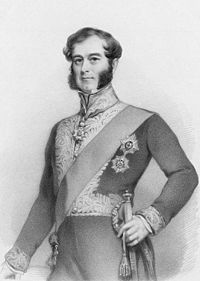Richard Temple-Grenville, 2nd Duke of Buckingham and Chandos
|
His Grace The Duke of Buckingham and Chandos KG GCH PC FSA |
|
|---|---|

The Duke of Buckingham and Chandos by Richard James Lane.
|
|
| Lord Privy Seal | |
|
In office 3 September 1841 – 2 February 1842 |
|
| Monarch | Queen Victoria |
| Prime Minister | Sir Robert Peel |
| Preceded by | The Earl of Clarendon |
| Succeeded by | The Duke of Buccleuch |
| Personal details | |
| Born |
11 February 1797 Stowe House, Buckinghamshire |
| Died |
29 July 1861 (aged 64) Great Western Hotel, Paddington, London |
| Nationality | British |
| Political party | Tory |
| Spouse(s) | Lady Mary Campbell (1795-1862) |
| Alma mater | Oriel College, Oxford |
Richard Plantagenet Temple-Nugent-Brydges-Chandos-Grenville, 2nd Duke of Buckingham and Chandos, KG GCH PC FSA (11 February 1797 – 29 July 1861), styled Viscount Cobham from birth until 1813, Earl Temple between 1813 and 1822 and Marquess of Chandos between 1822 and 1839, was a British Tory politician. He served as Lord Privy Seal between 1841 and 1842.
Two events in his life were remarkable, given the era he lived in and the position he held in society as a duke: firstly, he obtained a divorce at a time when that required an act of parliament; secondly, despite the great wealth to which he was born, he declared bankruptcy with debts of over a million pounds in 1847.
Born at Stowe, Buckinghamshire, the Duke of Buckingham was the son of the Earl Temple (later created the 1st Duke of Buckingham and Chandos) and Lady Anne, daughter of the 3rd Duke of Chandos. He was a paternal grandson of the 1st Marquess of Buckingham and a great-grandson of Prime Minister George Grenville. He was educated at Eton and Oriel College, Oxford.
Buckingham sat as Member of Parliament for Buckinghamshire between 1818 and 1839, when he succeeded his father in the dukedom and entered the House of Lords. Two years later, in September 1841, he was sworn of the Privy Council and appointed Lord Privy Seal by Sir Robert Peel, a post he held only until February 1842. He was appointed a Knight Grand Cross of the Royal Hanoverian Order in 1835, elected a Fellow of the Society of Antiquaries in 1840 and made a Knight of the Garter in 1842.
...
Wikipedia
